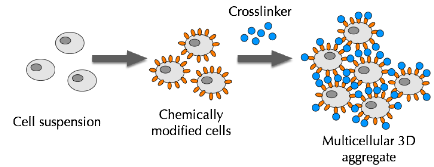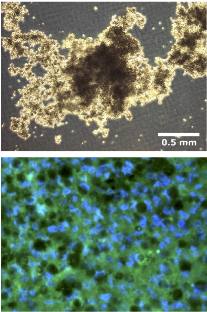 |
||||
|
|
||||
 |
||||
Research - 3D Cell Aggregates |
||||
Within living tissues, cells exist in complex microenvironments experiencing 3D signalling between themselves, their neighbours, and the extracellular matrix as well as a variety of chemical and mechanical cues. Traditional culture techniques are usually 2D and do not recreate the 3D architecture cells should experience. Hence, for the optimal generation of functional tissues, and for the delivery of therapeutics cells, this 3D environment should be recapitulated. Most cells do not naturally form 3D structures when cultured in vitro, so we have developed strategies to readily and rapidly form large, 3D cell aggregates. To do this, we chemoselectively decorate cell surfaces with molecules that can subsequently bind to a specific crosslinker, resulting in cell aggregation: |
||
 |
 |
|||||
To date, we have investigated two approaches. Firstly, cells have been decorated with biotin and crosslinked with avidin. Secondly, we have engineered cells with maltol and subsequently induced aggregation using Fe3+ ions. In both approaches, aggregates of greater than 1 mm can be generated in a matter of minutes and we have also produced mixed aggregates of cells and polymer microparticles for potential growth factor delivery applications. This strategy can be applied to any cell type, including stem cells, and has numerous possible applications in tissue engineering, cell delivery, the study of disease and generating accurate in vitro models for pharmaceutical testing. |
||||||
Low power image of multicellular aggregate (top) and fluorescence image of a hybrid aggregate cross-section (bottom) showing cell nuclei and cytoplasm (blue, green) and PLGA microparticles (black) |
||||||